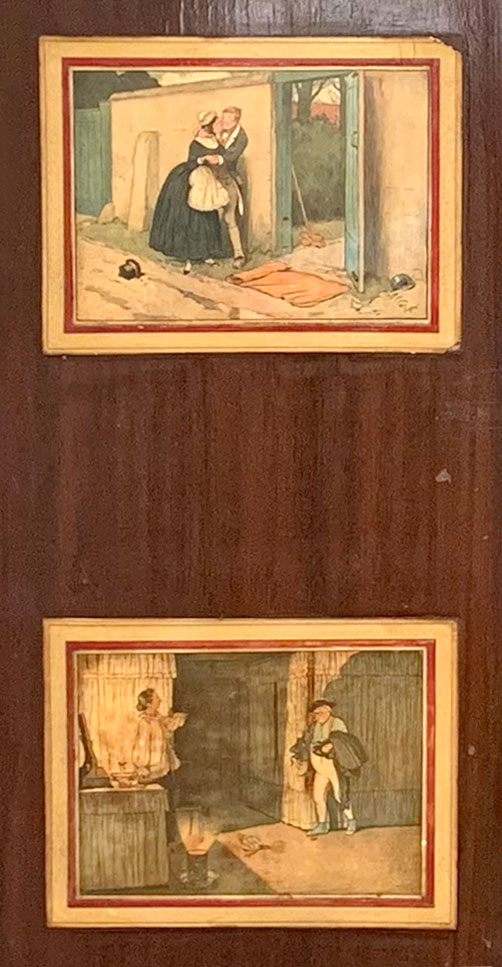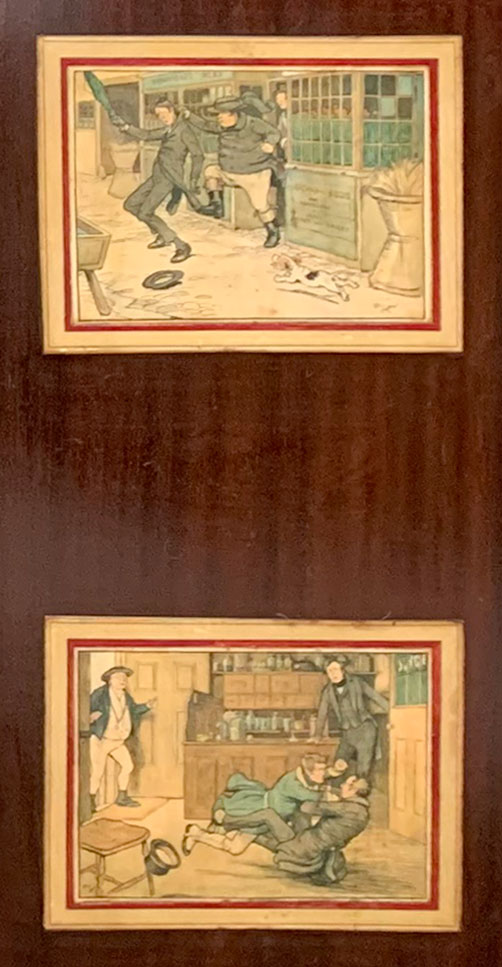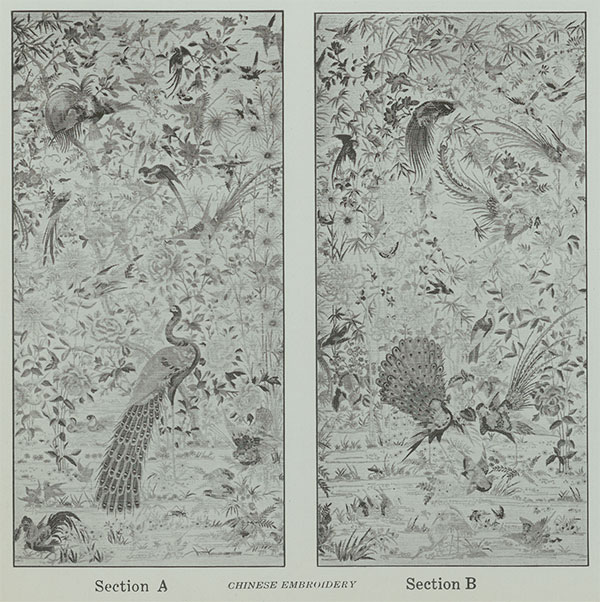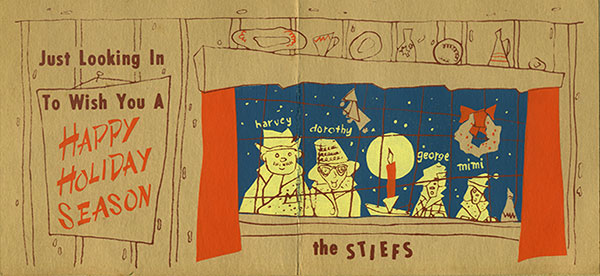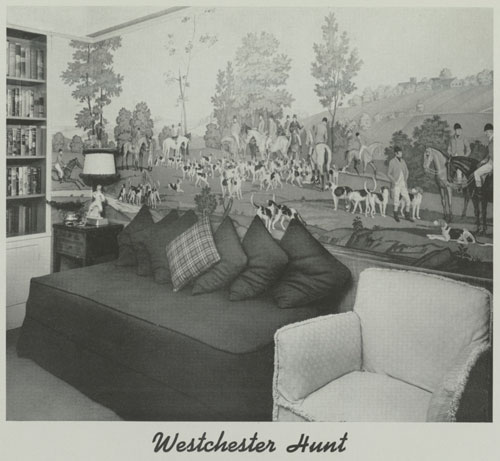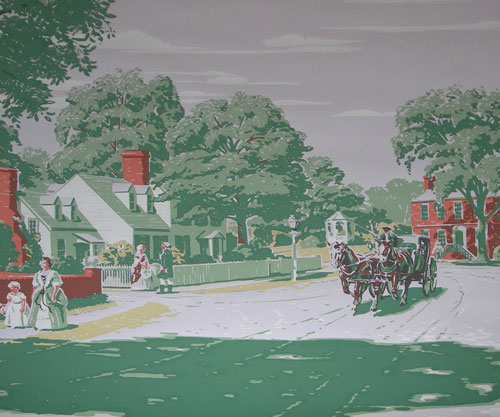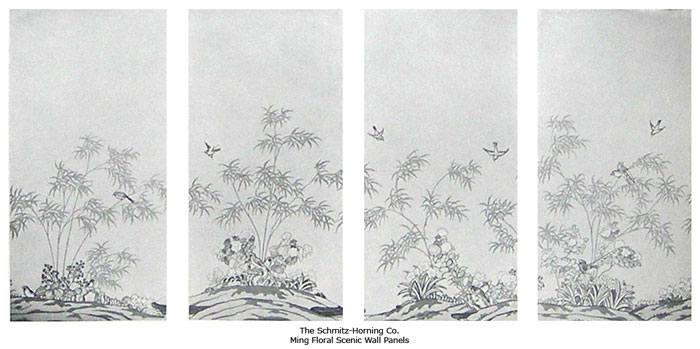By Janet Dodrill
Reproduced from the article, Lithography Spells Style For Schmitz-Horning Co. article, Wallpaper and Wallcoverings magazine, Convention Issue, November, 1961.

Wallpaper and Wallcoverings Magazine, Convention Issue, November, 1961.
In 1796, when a playwright named Aloys Senefelder invented a new process for publishing his plays and music, he probably never dreamed his method would be used to reproduce hundreds of different things – among them wallpaper scenics.
The process Senefelder invented is called lithography. It was adapted in 1905 by the Schmitz-Horning Co. Cleveland, Ohio, to make wallpaper murals.
The Cleveland firm is the only firm in the United States producing decorative types of scenic papers by the lithographic process. The technique is also used, however, to make photo murals.
Lithography offers two advantages in the production of scenic papers. First, it is comparatively inexpensive, and secondly, there is plenty of latitude in producing various effects. Until recently, Schmitz-Horning scenics were done in a full rainbow of colors with blurred outlines. The new lines, however, have adopted the crisp, simple styling popularized by the more expensive sold screen printed scenics.

A Schmitz-Horning Co. lithograph “direct rotary” press here “grounds” on a double coat of an oil based paint. Only one color can be printed at a time.
“When Schmitz-Horning first started making scenics, customers liked many colors and complicated designs,” explained Warren Schmitz, company president. “In fact, it took more than two years’ work to complete the plates for just one scenic.”
Some color ways of this scenic were made in 14 printings, one print at a time. The complicated motif of butterflies, flowers and other greenery gave the effect of elaborated detail found in oil painting. This elaborateness has been abandoned by the firm in its new scenics which are painted “color for color,” according to Mr. Schmitz.
Yet today’s S-H murals are being produced in much the same way as they were in 1905 when Hugo M. Schmitz, Warren Schmitz’s father, and Will Horning, a lithographic artist, Founded the firm. Horning sold out his share of the firm in 1921, and it has been run by the Schmitz family since.

Lithographic artist Frank Mayer traces a color area of a new Schmitz-Horning Co. design on a transparent tissue.
Hugo Schmitz was an artist of some note whose work had been hung in the Metropolitan Museum of Art. Since worlds of art had long been reproduced by the lithographic process, Schmitz felt that wallpaper scenics could be made in the same way and much more economically than the hand-painted and wood blocked ones then available. So was introduced the first mechanized method of producing scenic wallpapers.
Within the firm’s first year of business, it established a modest distribution throughout the country, with a plant in downtown Cleveland as headquarters. In 1912 Schmitz-Horning moved to a two-story building at 777 E. 82nd St., where it has remained ever since.
In the plant of 15,000 square feet, the firm produces it lines of Murals of American, Lithographed Mural Wallpaper and Mural Maps. Schmitz-Horning was probably the first firm in the country to come out with a map specifically as a wallpaper scenic and called a “Mural Map.”

Mrs. Harry James, bookkeeper at Schmitz-Horning Co. for 37 years, checks a customer file. The firm puts out only its own lines which have been distributed throughout the U.S. for more than 50 years.
Mr. Schmitz estimated that his lithographed murals sell for about one-third to one-half the price of handprinted ones. The lower prices are due to the fact that lithographed wallpaper, although not made at the mass production rates of machine prints, can still be put out much faster than screen printed scenics requiring many hand operations.
The basis for lithography is a simple one: – under certain controlled conditions, oil and water will not mix. This process utilizes a flat printing of roughened zinc in contrast to a raised or engraved surface.
But before a plate can be made, a number of preliminary steps must be taken at the Schmitz-Horning plant. First, a design is needed. Providing these are free lance artists. Sometimes the artist will suggest his own design, while other times Mr. Schmitz will make a definite assignment.

Warren Schmitz, president of Schmitz-Horning Co., stands beside a panel of “Sanibel”, new Schmitz-Horning lithographic mural featuring crisp, clean styling.
The finished art is usually half the size of the murals, which average 10-13 feet in width. Some scenics, however, exceed 20 feet. One well-known Schmitz-Horning design, “Westchester Hunt,” comes in 10 sections and runs a grand total of 11 1/3 feet.
A Black and white photograph of the finished art is blown up to full mural size. The Schmitz-Horning lithographic artist makes a tracing on tissue over the photograph. The tracing is an art in itself, since the artist is using a black and white photograph as his guide and must study the full color sketch to select colors. Each color must have its own tracing.
The tracings are then “rubbed down” on a zinc plate by putting them through a transfer press. The artist now works on the plate with a liquid crayon. Using the tracings as a guide he works in the color values onto the plate. Although a separate plate is required for each color in the design, both the dark and light values of a color can be carried on a single plate.
The plate is next put through a solution of gum arabic to delineate between the print and non-print areas. Parts of the surface protected by crayon are not affected by the chemical bath. But the unprotected surfaces react to the solution and take on an oxide coating. The plate now has the ability to attract and retain water on its surface.
The crayon is removed after the gum arabic bath, and the plate is ready for use. Its printing areas – those originally covered with crayon – pick up and transfer oil inks. The non-printing areas, those carrying a coating of oxide, will pick up and retain water.
Schmitz-Horning has three lithograph “direct rotary” presses plus a smaller press for scenic miniatures. The presses are sheet fed. The plate is attached to a large cylinder and prints directly on the sheets of paper which are carried around a second cylinder. Just one color is printed at a time and paper sheets are fed into the presses by hand.
Wallpaper scenics are but one of the many decorative and useful items reproduced by the lithographic process. May famous artists of past and present have produced lithographic prints which occupy a high rank in the graphic arts. Lithography is also the basis of the offset process used to print blotters, booklets, calendars, programs, greeting cards, children’s books, stationery, sheet music, maps and even cigar bands.
The oil-based paints used in the lithographic process have made Schmitz-Horning scenics automatically washable. “We’ve improved the process throughout the years, but even our earliest efforts could be washed,” said Mr. Schmitz. “A Woman wanted to know how to clean one of our old scenics in her house. I gave her very careful instructions, but the cleaning woman went ahead and washed it with LesToil. It came out beautifully.”
Schmitz-Horning’s new crisp styling is designed to appeal to modern families who want smart decor at a price they can afford, according to Mr. Schmitz. “Lithography still offers the most practical, mechanized method for producing large-scale designs,” he concluded.
Copyright article and images. All rights reserved. Not to be used without permission.
#schmitz-horningcompany #schmitzhorning #schmitzhorningcompany #wallpaper #wallcoverings #wallpaper #chromolithograph #lithograph #lithographic #cleveland #clevelandohio #wallmural #wallpaper #frieze #wallfrieze #panoramic #landscape #hugoschmitz #warrenschmitz #kro-mura #kromura #san-kro-mura #sankromura #venwood #printing #scenicwallmural #janetdodrill








 Posted by janetdodrill
Posted by janetdodrill 
